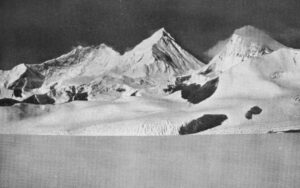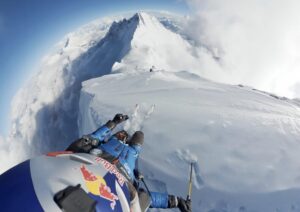Annapurna
Yesterday, we conveyed the first impressions of some of the 30 people who summited Annapurna. According to outfitters, four of these climbers summited without supplemental oxygen: Giampaolo Corona, Tim Bogdanov, and Hans Wenzl of Seven Summit Treks, and Grace Tseng of Dolma Outdoor. The first three also had no support Sherpa.

Grace Tseng on the summit of Annapurna. Photo: Grace Tseng
Taiwan’s Grace Tseng also confirmed on social media that she summited without O2.
India’s Kasturi Deepak Savekar of the 8K Expeditions team also made it to the summit, at 12:25 pm on April 28. Savekar, born on September 5, 2001, became the world’s youngest woman to reach the top of Annapurna. She used O2.

Kasturi Deepak Savekar, 21, on the summit of Annapurna. Photo: Kasturi Deepak Savekar
Moeses Fiamoncini was making his second attempt on Annapurna without supplemental oxygen. He failed but survived to tell the tale. He recounts that two hours below the summit, at 7,900m, he began to have symptoms of altitude sickness, accompanied by mental confusion, difficulty walking, dizziness, and nose bleeds. This happened at 9 am.
He sat for two hours, even though he knew the symptoms were not going to go away. Two climbers going up passed him at one point and encouraged him to continue. They were the ones who later had to be rescued.
“I understand their decision to continue climbing,” he said. “They are both excellent climbers with extensive experience.”

Trifish Chan of Taiwan also attempted Annapurna without bottled O2. She failed but says that she will try it again another time. Above, her drawing of Annapurna.
Another no-O2 summiter?
Yesterday, May 1, Babu Sherpa, the managing director of Nepal’s Peak Promotion, announced in The Himalayan Times that one of his clients, 41-year-old Indian Skalzang Rigzin, also climbed Annapurna without bottled O2.

Indian climber Skalzang Rigzin claims to be the first Indian to climb Annapurna without O2. Photo: The Himalayan Times
This comes as a surprise, as Peak Promotion did not announce earlier that one of their clients summited without O2. Of the team’s Indian climbers, four summited on April 28 at 2:18 pm, including Skalzang Rigzin. Kami Sherpa and Urgen Sherpa assisted the group.
One climber from this group, Palkesh Kalma, said that he reached the top around the same time. As they began to descend, a bad snowstorm enveloped them just 90m below the summit, and they lost their way.
Kalma recalls that they ran out of oxygen. The storm worsened, and the wind rose. At one point, Kalma wasn’t sure that they’d make it back to their high camp.
They struggled for almost four hours to find the fixed ropes in bad visibility. Finally, with the help of a Sherpa from one of the other groups, they found it and then started to descend. They safely reached their Camp 4 at 6,700m at 12:30 am. Kalma, who climbed with O2, had been on the go for more than 27 hours.

Palkesh Kalma summited, then a snowstorm swept in, pinning them down for hours. Photo: Frame from a video by Palkesh Kalma
Unidentified rescue
We know that a helicopter longlined one Indian climber to safety on April 29, as everyone struggled to descend. The Indian was in critical condition from severe AMS. The helo later airlifted him to a Kathmandu hospital. We still do not know the identity of this person or whether he summited.
Giampaolo Corona, one of the two who became lost after reaching the summit and also needed rescue, said that the storm caused him to lose his way to Camp 4. Corona then spent two nights in the open at over 7,000m, without a tent or water.

A ravaged Giampaolo Corona in the hospital in Katmandu, with friends. Photo: Arjun Vajpai
Tim Bogdanov, who seems cheerful despite his frostbite, also remains in the hospital.
Until now, we have had no news from the third climber to summit Annapurna without oxygen or a personal Sherpa. Unlike his two companions, Hans Wenzl of Austria managed to reach Base Camp safely.
In an interview with Stefan Nestler, Wenzl said that the three climbers had placed their Camp 4 at 7,000m, 300m higher than the other teams. From there, they began their summit push.

The power of positive thinking: Tim Bogdanov in the hospital, with friends. Photo: Arjun Vajpai
The three of them (Wenzl, Bogdanov, and Corona) did not know each other beforehand, says Wenzl. But since they were going in the same style, they teamed up.
Each of the three had his own tent. Corona, Bogdanov, and Wenzl started for the summit at the same time, around 1:30 am. Wenzl and Corona went quickly for three hours. Bogdanov was slower from the start.
Three hours after leaving Camp 4, Corona slowed down, but Wenzl kept his relatively fast pace. He knew that in the afternoon, the weather would deteriorate.

Hans Wenzl on the summit of Annapurna. Photo: Hans Wenzl/Abenteuer-berg.de
”As I descended back from the summit, I met Tim [Bogdanov] first, still going up. And then Giampi [Corona], which was a surprise to me, as I actually thought he turned back,” Wenzl told Stefan Nestler.
Around 4 pm, the storm hit him too, and he had a lot of trouble finding his tent. Eventually, he did. However, Corona and Bogdanov did not reach Camp 4 that night. This was Wenzl’s tenth 8,000m summit without bottled oxygen.
Everest
On the Tibetan side of Everest, a team of 11 Chinese summited on April 30, according to Mingma G.
Meanwhile, on the Nepal side, the groups continue to acclimatize, and the Sherpas are preparing to fix the ropes to Camp 4.
David Goettler will again try to climb without O2. Goettler already climbed Mera Peak this season to acclimatize. ”It will be only one more dent in my ego if it doesn’t work out,” he wrote.

David Göttler ready for the next try. Photo: David Göttler
Marc Batard, who is trying to avoid the Khumbu Icefall by going by the Nuptse side, is making progress. Recently, he and his son Alan reached 6,000m via the new route. Batard has now had to stop for a few days because of an illness. The 70-year-old former speed climber aims to climb Everest without bottled O2.

Pasang and his son on Batard’s new route. Photo: Marc Batard
On Makalu, Kangchenjunga, and Lhotse, the acclimatization rounds continue.
Szilard Suhajda of Hungary will attempt Lhotse without bottled oxygen or personal Sherpa support. He has already spent two nights at 7,300m and will push for the summit soon.
Toward the end of this week, there may be a new summit attempt on Kangchenjunga, according to Nepali climber Purnima Shreshta.
On the South Face of Lhotse, the Sherpa members of Hong Sung Taek’s team have already fixed the ropes almost to Camp 2. Climbers are doing their rotations above Camp 1.
In Dhaulagiri, the few teams in Base Camp continue to wait for a suitable weather window.

Climbers acclimatize on the lower section of the South Face of Lhotse. Photo: Pasang Rinzee






